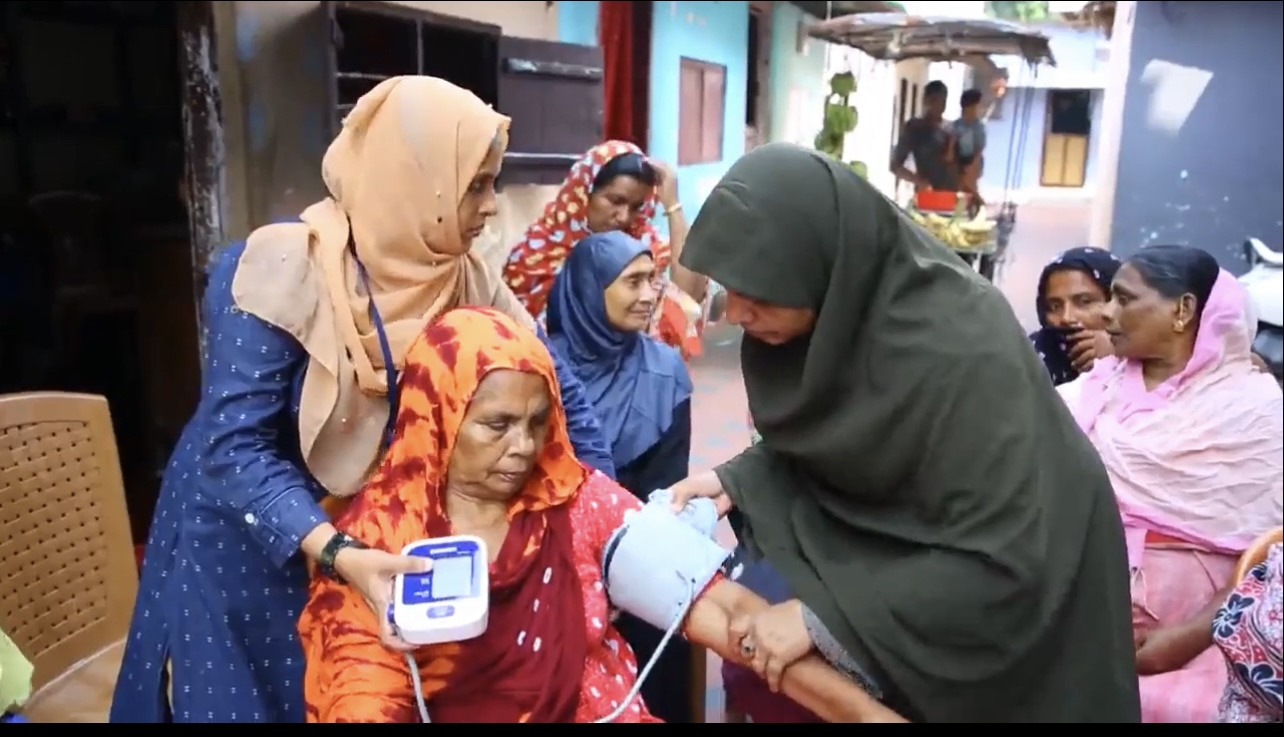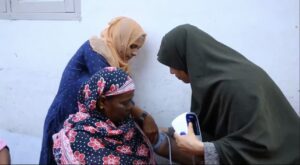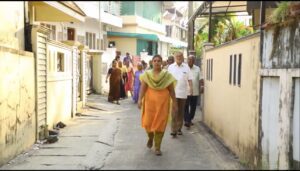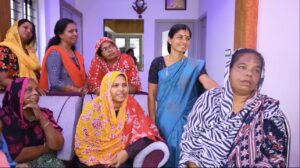Researchers from Amrita Institute of Medical Sciences and Research Centre trained the women to help others to keep BP under check.

Women SHGs are crucial in controlling hypertension in the community. (supplied)
“Kudumbashree means different things to different people,” the poverty eradication mission’s website says while tracing the history of the three-tier community network of women the Kerala government had set up in 1997.
For the people in 10 slums in Kochi, Kerala’s commercial capital, Kudumbashree, as the name implies — “prosperity of the family” — is associated with healthy living.
Kudumbashree members are mostly from the lowest strata of the society, many of them school dropouts like the 43 women who are now making a change in Kochi’s 10 urban slums.
Armed with blood-pressure apparatuses, knowledge on hypertension and some methods to alleviate the lifestyle disease, these 43 women have successfully brought down high blood pressure in slumdwellers assigned to them.
The initiative is the brainchild of a group of researchers, who chose the women’s network for community intervention. A study on the effectiveness of the initiative was recently published in the BMJ medical journal.
“Elevated Blood Pressure (BP) is the leading risk factor globally and an important, preventable cause of premature mortality,” lead researched Dr Rakesh P Suseela told South First.
“High BP Is also one of the major risk factors for ischaemic heart disease, stroke, other cardiovascular diseases and kidney diseases,” he pointed out.
“The study was carried out to assess the effectiveness of community-based education and peer support in reducing the systolic blood pressure in urban slum-dwellers with hypertension,” Dr Rakesh, also the faculty in charge of the Centre for Public Health, Amrita Institute of Medical Sciences and Research Centre, added.
The researchers selected 10 Kochi slums and through the National Health Mission and other stakeholders, approached local leaders.
The local leaders were assigned the task of choosing the women from the community, who could dedicate time and are acceptable to the community.

Women from self-help groups in urban slums worked for bringing down blood pressure in communities living in 10 urban Kochi slums in Kerala. (Supplied)
“The challenge was to win the community’s trust in this study and also in the women who approached them. Normally, healthcare is associated with hospitals and doctors. For them to see women from their own community carrying the BP apparatus, checking BP, holding meetings on diet and exercises, etc., was new and challenging,” Dr Rakesh said.
“Also, not all women are acceptable to the community. So we thought the local leaders would be the best selectors to choose the women who can dedicate six months for this project and also undergo training,” he recalled.
Once the women were selected, the researchers held a workshop for all stakeholders, in which primary healthcare providers were also invited. The workshop finalised an intervention strategy.
The key strategy was to select 20-25 households with patients with hypertension. One volunteer was assigned to the households.
“A baseline survey found that each household had at least one member with hypertension. As many as 1,952 individuals were selected for the study. The volunteers were divided into batches of 15 members each and they were trained for 18 hours,” Dr Rakesh said.
The training created awareness about hypertension, diet that one should follow, the importance of exercise and how to check weight and record blood pressure using the BP apparatus.
Volunteer Shamla Navas is a happy woman. She expressed satisfaction over the success of intervention programme.
“We organised monthly peer meetings in which we initially recorded their weight, blood pressure, dietary habits, medications and their daily routine. Since we belonged to the same community, it was easier for us to understand their difficulties and change their dietary and lifestyle habits,” she said.
The women faced resistance during the initial days. “There was some resistance with people questioning our qualification and the nature of work we were assigned to do. But, when they noticed changes in some of the participants, others, too, accepted us,” Shamla added.
Besides imparting knowledge, psychological support, too, was provided to the community.
“We benefitted a lot from the volunteers. Bindu educated us on BP and why it should be controlled and how to do it. Every month our BP, blood sugar and weight were recorded. Even what we ate was noted. My BP came down in the initial months itself,” Shahida, a resident of Puthukkattuparambu, said.
The women succeeded in altering the dietary and lifestyle habits of people across all age groups. Dr Rakesh explained that if one person of the family was part of the study, the food habits of that entire household automatically changed.
“I have reduced the use of salt and sugar in my house. We all exercise at home and try to take healthy food,” Fathima, another participant, said.
The volunteers also introduced group yoga classes, walking clubs, and even makeshift gyms. Speaking to South First, Meharunniza, another volunteer, said the people were very supportive in the areas she worked.
Besides regularly attending the meetings, they followed the exercise regime. She is continuing with them even after the study period.

A volunteer leading a group-walk session held as part of the intervention programme to reduce hypertension in the community. (Supplied)
Interestingly, while the researchers and volunteers were working on people’s hypertension issues, the team at the end of the six-month study found a remarkable improvement in the blood sugar levels of the participant’.
“This indicates that diabetes is majorly a lifestyle-related disease and can be controlled by making changes in their lifestyle and food habits,” Dr Rakesh explained.
Meharunniza conveyed that participants had often complained of non-availability of medicines.
“We helped them to get medicines but it was not enough. We then requested our local counsellor to set up a ‘Vayomithram’ unit in our locality. It was inaugurated on Monday, 28 November,” she said proudly.
Kerala government’s ‘Vayomitram’ project mainly provides free medicines, palliative care and counselling.
Dr Rakesh said the initiative proved to be a low-cost strategy to control blood pressure. “A 6mm reduction was seen in the participants. If there is a drop of 5mm of blood pressure, it means a 10 percent reduction in cardiovascular mortality. If 20 percent of them had BP under control before the study, after out intervention, it doubled to 40 percent,” he added.
The researchers also found that the reduction in BP was more evident among those with higher Body Mass Index. While the prevalence of hypertension was the same in men and women across ages, the intervention benefited the majority of the elderly population.
After the study period the state health department under the NHM absorbed the communities and the volunteers to continuing the programme.
“The study is over but we are still following up with them. In our module, it is stated that we will monitor people with lifestyle diseases for a longer period and hence we are continuing the intervention,” Meharunniza said.
Dr Rakesh explained that the community members demanded that the study be extended to other diseases such as diabetes so that they get easy access to blood tests and routine echo cardiograms.

Happy participants of the intervention program which succeeded in reducing hypertension amongst members of the community in 10 slums of Kochi. (supplied)
The volunteers said people in other localities are seeking the extension of the programme to their communities also. They said ASHA (Accredited Social Health Activists) workers had asked them why the initiative was not rolled out in other localities.
“If it is extended to other areas, everyone will support the initiative. It will benefit all and it should be implemented in other areas too,” Mehrunniza opined.
Meanwhile, Dr Rakesh and his team have recommended the replication of the interventional programme across the country.
“India has over 6.6 million SHGs with 72 million members,” the research paper mentioned, indicating that it would be possible to initiate the programme nationwide
Further research is needed to understand the adaptability of the programme. “Working with wider community groups other than SHGs could further expand this programmed,” the study said.
“There is also a potential to design and implement similar interventions in other places where peer support groups are already active and contribute to the global agenda for hypertension control and CVD prevention,” it further said.
Dr Rakesh said the method can be extended to medication adherence, diabetes, and controlling obesity.
Dr Bipin K Gopal, State Nodal Officer, NCD Control, of Kerala’s Directorate of Health Services, said he was “convinced with the success and gaining inspiration from this model. The health department is planning to scale this up to entire state.”

Apr 23, 2024

Apr 23, 2024

Apr 23, 2024

Apr 23, 2024

Apr 23, 2024